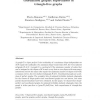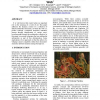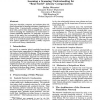148 search results - page 11 / 30 » On Perfect Completeness for QMA |
ENDM
2008
13 years 8 months ago
2008
A graph G is clique-perfect if the cardinality of a maximum clique-independent set of H equals the cardinality of a minimum clique-transversal of H, for every induced subgraph H o...
KDD
2012
ACM
11 years 11 months ago
2012
ACM
Trust networks, where people leave trust and distrust feedback, are becoming increasingly common. These networks may be regarded as signed graphs, where a positive edge weight cap...
MPC
2000
Springer
14 years 11 days ago
2000
Springer
Abstract. We present an algorithm for inverse computation in a rstorder functional language based on the notion of a perfect process tree. The Universal Resolving Algorithm (URA) i...
DNIS
2005
Springer
13 years 10 months ago
2005
Springer
It is well known that context plays an important role in the meaning of a work of art. This paper addresses the dynamic context of a collection of linked multimedia documents, of ...
ANLP
1992
13 years 10 months ago
1992
This paper describes, compares, and evaluates three different approaches for learning a semantic classification of library titles: 1) syntactically condensed titles, 2) complete t...



